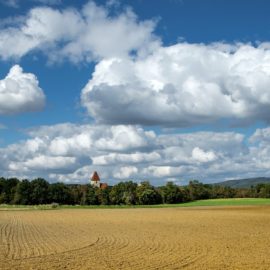
Wild turkeys are making a come back bot here and elsewhere.
Chances are the turkey you’ll gobble this week was not shot in the wild. But here’s the thing: It could have been, thanks to decades of conservation efforts. Nationwide, the wild turkey has made a remarkable comeback after its numbers plummeted over much of the last century. In Louisiana, major progress has also occurred, though the state official overseeing wild turkey management says there’s still more work to do. For those with the opportunity, feasting on a wild bird for Thanksgiving will offer quite a different experience from the store-bought turkeys that the vast majority of the country will slide into the oven early Thursday. The oversized factory-farmed birds often cannot even fly or mate naturally because of how they’ve been bred. Wild turkeys, on the other hand, can run 18 mph on foot and fly 50 mph, according to the U.S. Fish and Wildlife Service. For John Kanter of the National Wildlife Federation, wild birds come with a real taste, not to mention a connection to the natural world, unlike the comparative blandness of the industrially farmed variety. His Thanksgiving dinner in New Hampshire will include a wild turkey he hunted himself. “Wild turkeys are thought of as kind of the ultimate conservation success story, because their numbers had dipped into the tens of thousands,” said Kanter, senior wildlife biologist with the federation. “And now they’re back up in the millions.”
nola.com
Nationwide, there are about 7 million turkeys.
Current estimates put the number of wild turkeys nationally at around 7 million. They’ve become so numerous in Kanter’s area of New Hampshire he sometimes has to stop while on the road for a flock to walk past – essentially a turkey traffic jam, he said. It’s been no accident. The change in fortunes for a game bird steeped in American lore has come about because of careful management practices nationwide, from tight hunting restrictions to restocking efforts. The causes of the decline were primarily overhunting and loss of habitat. Urban sprawl and other forms of human development gradually took space from the birds, while hunters at one point assumed the population was endless.
Louisiana began regulation at the turn of the 1900’s but they were very lax, especially when compared to today.
Louisiana’s earliest-known turkey hunting restrictions were enacted in 1905, said Cody Cedotal, small game and turkey program manager for the Louisiana Department of Wildlife and Fisheries. And even in the unlikely event that those rules were diligently respected, they were not really restrictions at all when compared to today’s stringent requirements. Back then, hunters were allowed 25 birds between December and March. Today, while the state’s turkey hunting regulations vary slightly by region, no one is allowed to kill more than two birds per season, which runs for between 16 and 30 days. The season occurs in April, which means having to freeze your quarry if you plan to eat it for Thanksgiving. “We think they’re on the way back. I don’t know that they’ve fully recovered,” Cedotal said of Louisiana’s turkey population. “We saw some declines about five to eight years ago.” Adjustments were made in the hunting season to better account for peak breeding season after those declines, he said. “We got a little bit of encouraging news this past spring,” said Cedotal. “Our harvest was the highest it’s been since 2009. So that’s great. We’re encouraged by that.”
Our turkeys are the eastern wild turkey and the largest game bird in the state.
Louisiana is home to the eastern wild turkey, which Cedotal says is the largest game bird native to the state. Their numbers in Louisiana were estimated to be as high as 1 million in the 19th century, he said. A steep decline followed, and by the mid-20th century, there were only 14 isolated flocks for a total of fewer than 1,500 birds, Cedotal wrote in his most recent annual report. The state’s efforts to trap and redistribute birds to suitable habitat began in 1962, he said, and that has paid dividends, as have similar programs across the country after some trial and error on the best ways to do it, Cedotal said. The presence of wild turkeys throughout Louisiana now can be attributed to that program, he said. “It was all restocked at one point except for small, little isolated populations,” said Cedotal. The state estimates between 10,000 and 25,000 hunt turkey in Louisiana each year. For 2022, the validated number of birds killed was nearly 2,900, while the estimated number based on sampling was 9,100. Kanter says excise taxes on guns and ammunition have played a big role in conservation efforts for species such as wild turkey. He hopes the turkey success story can be used as an example for other species that have received less attention.
Their organization lobbied for the Recovering Americas Wildlife Act.
His organization has advocated for the passage of a federal bill known as the Recovering America’s Wildlife Act. One aspect of the bill would allow species whose declines are a concern – though not yet in a critical state – to qualify for restoration funds. “Whether it’s a wood thrush or a meadowlark or a sharp-shinned hawk or blanding’s turtle, there’s just so much of our wildlife that does not have a source of funding,” said Kanter.
Some Thanksgiving I would like to have one for dinner.



